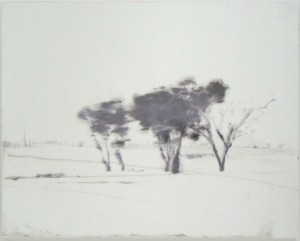Into the great, wide open
On view soon, at Manifest in Cincinnati, will be the work of David Smith, an Irish artist who now lives in Hong Kong. He works on a small scale, yet his images offer a feeling vast and empty, hinting at the notion of the void at the heart of Taoist and Buddhist philosophical traditions, which would seem to be his actual subject, rather than the aircraft, ships, buildings or mountains you can hardly make out through the haze. As a result his images bear a certain kinship to classic Asian art. Recently, an image of one of his paintings on the Manifest website impressed me so much I wrote to Jason Franz, the director at Manifest, and asked, “How does he do that?” I didn’t expect him to explain. It was a rhetorical question I often ask when I stand before work that impresses me so much I wish I’d painted it myself, as Smith’s does. Yet if you go to his website, you can get something that resembles an answer, up to a point.
When I first saw his paintings, they seemed so slight, so lacking in what one would normally consider a compositional armature, that I hardly paused to register the subtle complex polarities that seem tensely fused within each one of them—object vs. atmosphere, purpose vs. serendipity, presence vs. absence. Sometimes all of these oppositions seem to hold each other in check within a single image, where they all add up to one encompassing polarity: his ability to suggest an enormous and unbounded sense of space within the solitary confines of a tiny, rectangular MDF board.
If you check out his equally spare, modest website, you’ll read an artist’s statement that’s a welcome relief from all the nonsense these self-absorbed meditations can inspire. It’s a quiet, simple description of his work process itself and how it results in the mysterious images he ends up with. At the basis of his technique is a respect for and reliance on the unpredictable properties of diluted oil paint, how it diffuses and dissolves, coagulates and solidifies, has a life of its own, producing unexpected effects as Smith works toward the image he hopes will emerge. He makes his move and watches as the paint counters with an opposing move, as it were. And so it proceeds. As he puts it, it’s an alliance, a cooperative partnership, a dance, between artist and medium, hearkening back to Japanese gutai, where the medium virtually becomes the subject by being allowed to assert its true nature. Here it’s coaxed into doing something much more than simply assert what it is. Alchemy ensues.

Comments are currently closed.